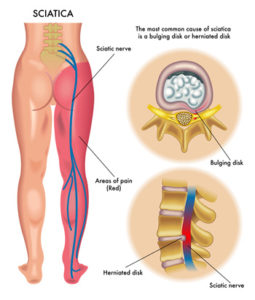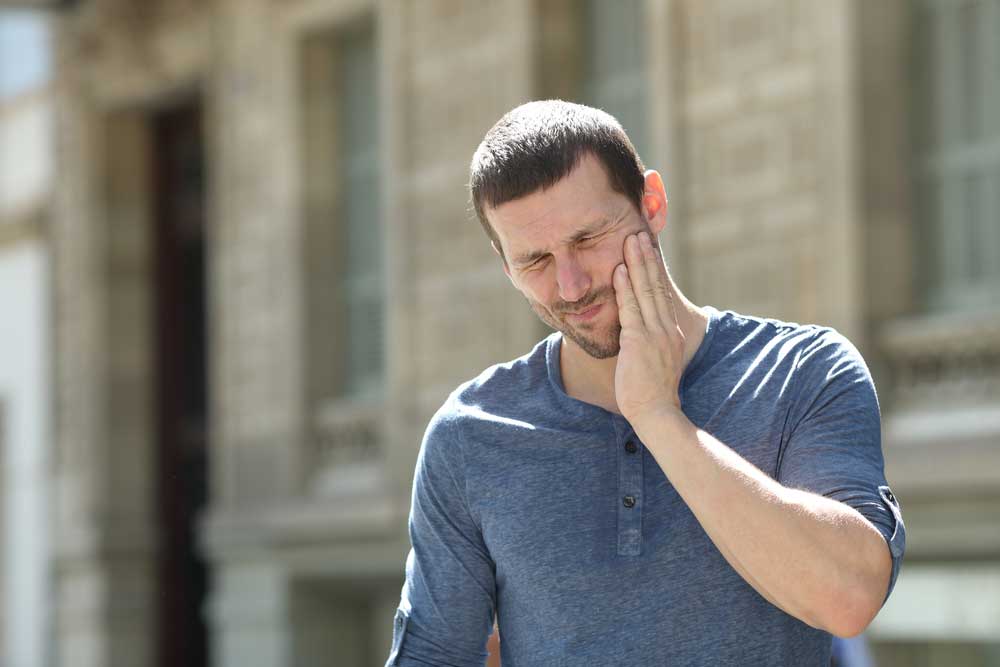Blog
 01 Mar 2020
01 Mar 2020
Bell’s Palsy Treatment

Bell’s palsy treatment
Today I want to share with you the safe and natural chiropractic options for Bell’s palsy treatment and explain how they work better than the conventional symptom management typically offered. But first, it helps to understand a bit about the condition itself.
What is Bell’s palsy?
Bell’s Palsy is a temporary form of facial paralysis that occurs suddenly and is often mistaken as a sign of a stroke. While not very common, it still affects an average of 40,000 people in the United States alone. Those between the ages of 15 and 45 are most likely to experience it. Bell’s palsy most often affects just one side of the face or the other but on rare occasions, it can affect both. This partial paralysis leaves you unable to control the facial muscles giving it a drooping appearance. Read More “Bell’s Palsy Treatment”
 15 Feb 2020
15 Feb 2020
Treatment for sciatic nerve pain
Treatment of sciatic nerve pain
Treatment for sciatic nerve pain does not have to require invasive procedures or addiction risk. Chiropractic is non-invasive, safe, and effective. In my previous post, Sciatic nerve pain relief, I shared what sciatica is and what causes sciatic nerve pain. Now, let’s compare the available treatments and take a more in-depth look at how and why chiropractic is the best option. Read More “Treatment for sciatic nerve pain”
 01 Feb 2020
01 Feb 2020
Sciatic nerve pain relief
Sciatic nerve pain
Fast sciatic nerve pain relief is possible with the safe and effective chiropractic treatment options we offer here at Synergy Wellness. But first, we need to understand what it is and what it is not. Since sciatica is a very common reason for back and leg pain, it’s understandable that pain from unrelated causes is often mislabeled as sciatica. In those cases, it could stem from strained or damaged muscles or ligaments.
Where is the sciatic nerve?

Sciatic nerve pain is often uncomfortable, distracting, and even debilitating. Starting in the lower back, it can extend down the leg and into the foot and toes. The source of actual sciatica pain comes from irritation of the sciatic nerve. Pressure or pinching of this sciatic nerve that originates in the L4 and L5 vertebrae in your lower back is the cause of most sciatica pain, hence its name. If you take a look at the sciatic nerve diagram, you’ll see that the sciatic nerve is the large nerve that runs down the back of each leg. Like a large river created by smaller streams, five pairs of nerves exit the spine in the lower back to form the two sciatic nerves. Read More “Sciatic nerve pain relief”
 15 Jan 2020
15 Jan 2020
Cox flexion distraction technique for chronic pain
Cox flexion distraction technique for chronic pain

Chiropractors trained in the Cox® Technic method use Cox flexion distraction technique for the successful treatment of chronic pain.
About one-third of Americans report that they suffer from some form of chronic pain. It is also the number one cause of long-term disability in the United States. According to a 2019 Dept. of Health & Human Services report, pain affects more Americans than diabetes, heart disease, and cancer combined.
Many Americans suffer from chronic lower back pain, neck pain, and migraines caused by a long list of conditions that can be treated with non-invasive chiropractic care. When treating chronic pain stemming from disc herniations and bulges, spinal stenosis, and nerve pains like sciatica, one chiropractic technique is considered the Gold Standard and is the most researched chiropractic procedure. It’s called Cox flexion distraction Technique.
Read More “Cox flexion distraction technique for chronic pain”
 01 Jan 2020
01 Jan 2020
Osteopathy and chiropractic differences
There are differences between osteopathy and chiropractic care, and knowing them can help you. Choosing a healthcare provider is an important decision and many people struggle with determining the right fit for themselves and their families. The seemingly endless list of fields and specialties doesn’t necessarily help. As you consider the kind of over-all care you are seeking, you will also want to factor in any current health concerns and personal preferences.
When it comes to back pain, most people choose to see either a chiropractor or an osteopath, but that is not the only problem they can help you with. Many people often wonder what chiropractic and osteopathy differences even are. The chiropractic and osteopathic fields do share many similarities; however, there are a number of important differences as well.
 15 Dec 2019
15 Dec 2019
Temporomandibular Disorders (TMJ)
Temporomandibular disorders are irritating at best and debilitating at worst. Jaw clicking and popping. Headaches. Earaches or tinnitus. Inflammation or jaw locking. Does any of this sound painfully familiar? Temporomandibular Disorders (TMD), frequently miscalled TMJ (temporomandibular joint), are a common cause of facial discomfort. The pain commonly associated with it can affect one or both sides of your face. It stems from problems with the jaw itself or facial muscles and nerves. More women than men are affected by TMD. These disorders mostly occur in patients between the ages of 20 and 40.
 What is the temporomandibular joint?
What is the temporomandibular joint?
The temporomandibular joint acts as a hinge connecting your jaw to the temporal bones in front of your ears. As with other joints, cartilage and discs act as a buffer between the bones. This “hinge” allows for the up and down and side to side movements necessary for talking, yawning, smiling, eating, laughing, and more. You typically use this joint over 5,000 times a day. In other words, it does a lot of work! You can probably guess that problems with the muscles, tissues, bones, or nerves in this area can have a major impact on your well-being and quality of life.
 01 Dec 2019
01 Dec 2019
Is a standing desk for you?
The standing desk is gaining in popularity. Is getting one the best option for you?
When to sit, when to stand
Without a doubt, there are numerous negative effects of regular, prolonged sitting. Over time, these negative effects can even cause cascading health issues. If you spend the majority of your day sitting at a desk, you are probably very familiar with a few of them. But there are some that may surprise you. Take a look at this list. Read More “Is a standing desk for you?”
 15 Nov 2019
15 Nov 2019
Occupational stress
As inevitable as death and taxes, occupational stress has become the new normal for most Americans. It could be considered a major workplace health hazard. Merriam-Webster defines stress as “a physical, chemical, or emotional factor that causes bodily or mental tension and may be a factor in disease causation . . . that tends to alter an existent equilibrium.”

Daily stress at work can lead to everything from actual physical illnesses and injury to substance abuse and depression. A Michigan public health study concluded that poorly managed anger (which is a common result of ongoing stress) can lead to a 2.5 times higher risk of death from heart disease.
Stress will always be a part of life. How we deal with occupational stress can change our health for the better or worse.
Our bodies are geared for a fight or flight response to stressors that resolve or finish quickly. Most occupational stress in today’s modern work environment is prolonged and rarely takes a break. Your body’s response that is meant to be short-term (increased heartbeat and respiration, increase in adrenaline and other hormones, etc.) becomes more long-term and just adds fuel to the fire.
 15 Oct 2019
15 Oct 2019
Standing desk or traditional desk?
Should you have a standing desk or traditional desk? When should you sit, and when should you stand?
Without a doubt, there are numerous negative effects of regular, prolonged sitting. Over time, these negative effects can even cause cascading health issues. If you spend the majority of your day sitting at a desk, you are probably very familiar with a few of them. But there are many that may surprise you.
Take a look at this list. Read More “Standing desk or traditional desk?”
 01 Oct 2019
01 Oct 2019
Bulging disc vs herniated disc: What’s the difference?
Bulging disc and herniated disc are commonly used terms for intervertebral disc problems. People also use terms like slipped and ruptured, but a disc does not actually slip, and ruptured just refers to a disc that has herniated. This can understandably cause some confusion when you just want to figure out what is wrong and how to fix it. For simplicity, we will stick with bulging and herniated for the rest of this post.
What are intervertebral discs, and what do they do?
In between each of your vertebrae, except the atlas and axis (C1 and C2), are flexible, gel-like pads. They are called intervertebral discs. They act as shock absorbers for your spine. These cushions absorb and disperse impact energy and provide spinal flexibility for bending and turning. Each disc is made of a tough cartilage surrounding a softer inner core called the nucleus pulposus.
Being an integral part of your spine, this puts them right next door to the bundle of nerves serving your spine and other areas. This is important to note because a bulging or protruded disc can press on these nerves and cause pain. Those nerves serve other parts of your body. That means you may feel pain in other areas, not just in your back. Read More “Bulging disc vs herniated disc: What’s the difference?”
 What is the temporomandibular
What is the temporomandibular